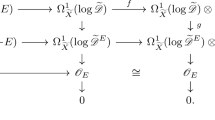Abstract
The self-linking number of generic smooth closed curves in Euclidean 3-space is studied. A formula expressing the self-linking number via the signs of the double points of a generic projection of the curve on a plane and the signs of the torsion at the points that are projected into inflection points is obtained. Every local invariant of generic curves is proved to be equal, up to an additive constant, to a linear combination of two basic local invariants: the number of flattening points and the self-linking number.
Similar content being viewed by others
References
G. Calugareanu, “L'integrale de Gauss et I'analyse des noeuds tridimensionnels” Rev. Math. Pures Appl.,4, No. 1, 5–20 (1959).
M. Barner, “Über die Mindestanzahl stationärer Schmiegebenen bei geschlossen streng-konvexen Raumkurven,” Abh. Math. Sem. Univ. Hamburg,20, 196–215 (1956).
V. I. Arnold, “On the number of flattening points on space curves,” Institute Mittag-Leffler. Report no.1, (1994–1995), pp. 1–13.
V. D. Sedykh, “A theorem on four vertices for a spatial curve,” Funkts. Anal. Prilozhen.26, No. 1, 35–41 (1992).
M. C. Romero-Fuster and V. D. Sedykh, “A lower estimate for the number of zero-torsion points of a space curve,” Beiträge Algebra Geom.,38, No. 1, 183–192 (1978).
I. Rodrigues Costa Sueli, “On closed twisted curves,” Proc. Amer. Math. Soc.,109, No. 1, 205–214 (1990).
F. Aicardi, “Topological invariants of knots and framed knots in the solid torus,” C. R. Acad. Sci. Paris Sér. I321, 199–204 (1995).
J. H. White, “Self-linking and Gauss integral in higher dimensions,” Amer. J. Math.,91, 693–728 (1969).
F. B. Fuller, “Decomposition of the linking number of a closed ribbon: a problem from molecular biology,” Proc. Nat. Acad. Sci. U.S.A.,75, No. 8, 3557–3561 (1978).
L. H. Kauffman, “Knots and Physics,” Word Scientific, Singapore, 1991, pp. 488–489.
V. I. Arnold and B. A. Khesin, “Topological Methods in Hydrodynamics,” In: Applied Mathematical Sciences. Vol. 125, Springer, 1998, pp. 177–179.
V. I. Arnold, “Topological issues in the theory of asymptotic curves,” Trudy MIAN,225 (1999).
Additional information
Scuola Internazionale Superiore di Studi Avanzati, Trieste, Italy. Translated from Funktsional'nyi Analiz i Ego Prilozheniya, Vol. 34, No. 2, pp. 1–8, April–June, 2000.
Translated by F. Aicardi
Rights and permissions
About this article
Cite this article
Aicardi, F. Self-linking of spatial curves without inflections and its applications. Funct Anal Its Appl 34, 79–85 (2000). https://doi.org/10.1007/BF02482420
Received:
Issue Date:
DOI: https://doi.org/10.1007/BF02482420



